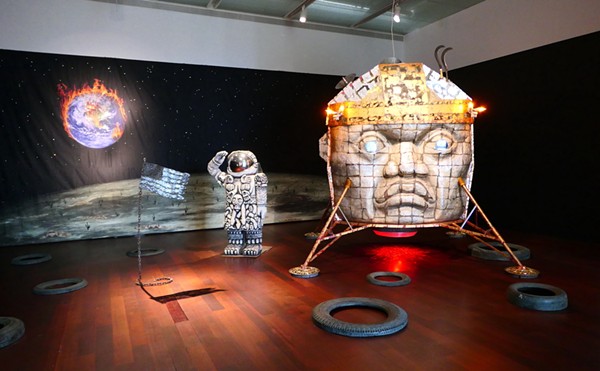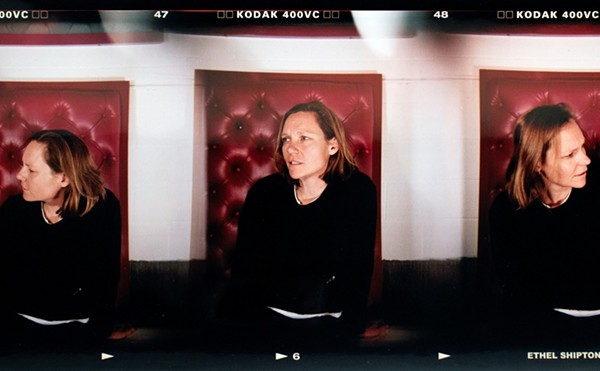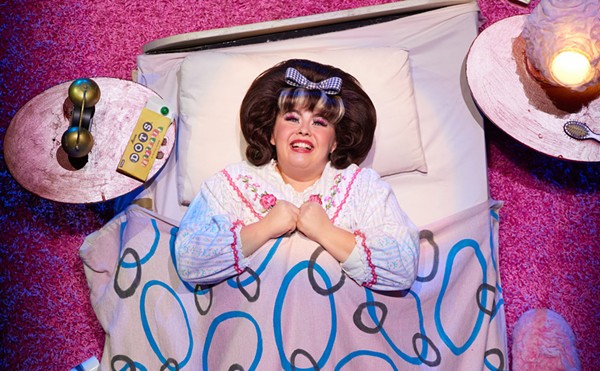Richie Budd’s politely wary about my request to record our interview. This reticence seems ironic, considering that his oeuvre — both as a solo artist and with the Denton-Brooklyn collective Good/Bad Art — is chock-a-block with performative antics, including loopy, Andy Kaufman-esque character work (“Jogger Buttermilk Hogger,” 1996), street-art theatrics robo-dubbed on video into Spanish (“El Dolar Un Minuto: Chalk It Up 2004”), and an Artpace residency that included a free, all-ages, Friday-night rooftop performance party with two bands, Marcus Rubio and the Gospel Choir of Pillows, and the charismatic, off-kilter Druggist. Budd’s business card even includes the URL to his YouTube account, where you can watch clips of the 1996-era Richie caress himself through sweatpants and get doused by the aforementioned buttermilk, or the 2007-model Budd cook hotdogs on a George Foreman grill for art-opening attendees as part of a sculpture-performance at New York’s Priska C. Juschka Fine Art.
It would seem he’s not shy about self-promotion, either. Richie Budd’s Flickr page includes scans of most of his press, some of which runs towards the bemused “WTF” variety. Before meeting Budd at Artpace to look at his installation-in-progress, I viewed screenshots and scans of past work, read descriptions, and perused videos, and still went into the interview a little flummoxed. Budd is frequently described as a “multimedia sculptor,” and his past 3-D phantasmagorias contain flashing and beeping electronic components, plastic containers of candy, bursts of smoke, and glue — a whole lot of glue, or sometimes melted plastic, or what appears to be … tar, maybe? Goo, in any case. In sculptures such as 2008’s “Whiteout” and 2007’s “Master
Fifty Beef,” it’s as though a polymer-spooge tsunami has coursed through the seldom-left den of some DJ fanboy who’s really into medical equipment, and the resulting catastrophe has been frozen in time as an anthropological artifact.
Budd can do beautiful, too, though his sleeker works are no less disquieting; two shadowbox sculptures pictured on Flickr, “Fucking Fear” and “Sno-job,” employ monochromatic ski masks, their mouths stunningly and starkly outlined in strands of cultured pearls; gorgeous, sexy, and scary as hell.
Then there’s The Object in Budd’s Artpace residency studio, a hulking monolith at first, looming darkly in the cavernous, dimly lit space. Budd has neither finished nor named it. It’s skeletal, somehow elegant, as-yet free of goo. Budd and I circle it as we talk (and I furiously take notes), and things begin to make more sense. He’s increasingly affable and engaged, offering up unselfconscious personal anecdotes and bits of self data, and he’s an interested listener, too, far less armored and deliberately obfuscating than photos of his work led me to expect.
A short, recalled bio of Budd: He’s originally from Michigan. One of his grandfathers was an OB-GYN, and the other was an engineer for Ford Motor company. His dad has a literature degree, and Budd grew up reading Hemingway, Henry Miller, and Jack London (recalling London in particular makes him laugh). He also had access to medical textbooks, and pored over their fascinating and sometimes terrible photographs. Richie Budd grew up in Fort Worth with a sister who’s now a veterinarian, and went to UNT in Denton, where he hooked up with the Good/Bad art collective. He came to UTSA to do an MFA, and stayed.
Budd sees the role of his artworks as strongly, interactively social, and hopes they don’t intimidate anybody. He always wanted to be a drummer, he laughs, but played the sax. He’s interested in all kinds of music, and has everything from dance-punk juggernaut LCD Soundsystem to the Rolling Stones to, endearingly, Bad Company on his iPod. He thinks the era of the “Van Gogh bullshit” archetype is over, or should be; that artists waiting passively for somebody else to discover them are “sitting on their hands.” Youth culture, DJ culuture, live music, and “freakin’ out” all influence Budd as much as any particular art-historical referents. He admires the kinetic robo-work of San Francisco collective the Seemen, and the SRL’s Mark Pauline, but he isn’t doing “destructo-machines.”
What Budd is doing, he tells me, is constructing a “meta-narrative” concerned chiefly with questions of “goal-orienteering” involving all five (-plus?) senses. Central to Budd’s thinking — but, he stresses, not necessary to enjoying his work — is the concept of Neuro-Linguistic Programming, an interpersonal communication model applied in psychotherapy, education, business management, and personal motivation. Budd mentions therapist-thinker Milton Erickson, whose unorthodox ideas form, in part, the basis for NLP. Erickson was a polio survivor stricken with near-fatal paralysis in childhood, who constructed a unique perspective as he lay there, unable to move anything but his eyeballs. He went on to become a psychiatrist, and came to view human beings as capable of constructing their own subjective reality, whose senses, feelings, ideas, and even neurotic coping mechanisms all have potential value that supersedes notions of dysfunction. He believed that the unconscious mind contains intrinsic wisdom that can help the patient to heal and communicate. As such, Erickson was an advocate and a practitioner of hypnosis for tapping into this unconscious stash of perceptual treasure, and believed that all states of consciousness are, to some degree, a trance. In fact, we’re all living a kind of shared trance in consensus, each with our own perspective.
I am seriously paraphrasing, here, and likely way imperfectly, but reading up on NLP and Erickson did give me, retroactively, a way into Budd’s particular Oz. Mindful of NLP’s various principles of neurology, Budd has constructed The Object at Artpace to interact with its viewers on several levels, literally and metaphorically. NLP has been dismissed by some as a New Age pseudoscience, but in any case, it’s another element in Budd’s arsenal. For instance, Budd explains to me the psychological mechanics of the human gaze; my oversimplified notes suggest that when we look down, we’re accessing feelings, whereas when we’re looking up, we’re accessing ideas. To that end, he’s strategically placed mirrors and lights within the structure, in a genuine attempt to guide and engage the viewer’s whole brain, subconscious, memory, “freakin’ out.” When I ask him about the emotional import of the work, he gently asserts that the root of “emotion” being “motion,” yes, he’s very much invested in moving the viewer.
Before presenting me with a demonstration of The Object in, well, motion, Richie asks me seriously if flashing lights might cause me to have seizures. Yikes. This is a scarifying moment, but once he plugs in some stuff and flips a few switches, fear evaporates. What had been an elegant but inert armature of walkers, a wheelchair, a fan, disco lights, and other seemingly random stuff becomes a sort of electro meta-karaoke ultra-toy party facilitator! It calls to mind a dancing contraption built for and by Stephen Hawking, or a funner version of that fighting armor Ripley wears in Alien III. French electro-pop duo Justice pours out of some speakers, and colored lights synchronized with the thump-thump beat shower dizzying patterns across the walls. A few Artpace fellows erupt into the studio as if on cue, and shout and dance ecstatically.
Richie laughs, and turns the machine off. He explains that when the piece is done, it will also contain smoke, snow, and an aromatherapy element. He’s a for-real, professional fragrance salesman by day, and very aware of the neurochemical link between scent and mood, and its proximity to memory. He nods gravely and sympathetically when I describe Estee Lauder’s Youth Dew as having the power to conjure up my late grandmother. He’s using citrus, lavender, and peppermint to awaken the senses and increase focus, he says, and to help the viewer ponder deeply the motivational questions posed by the work. And he’s not kidding. What’s arresting about Budd is that behind the sly theatrics and scary confrontational elements of his constructions, there’s a genuine earnestness, a desire to provide a unique experience for the viewer through hard work, research, and deep thought.
After leaving Budd and The Object at Artpace, I feel slightly freaked-out and hypersensitive for the rest of the day. Maybe it was the flashing lights. Maybe it was the bursts of music, or the abstract juxtaposition of medical elements and mirrors with Budd’s smiling, oddly softspoken aw-shucksiness, or the fact that I’m worried about having no audio recording of the visit. (One of my favorite scrawled notes, quoting him about foreign languages: “I learned some, but now I can’t do anything in French.”) But on some trance-y, hard-to-verbalize level, I’m a believer. •
VISUAL ART
New Works 08.3: Lu Chunsheng, Taryn Simon, Richie Budd
Opening reception:
6-9pm Thu, Nov 6
Free
Artpace
445 N. Main
(210) 212-4900
artpace.org

















